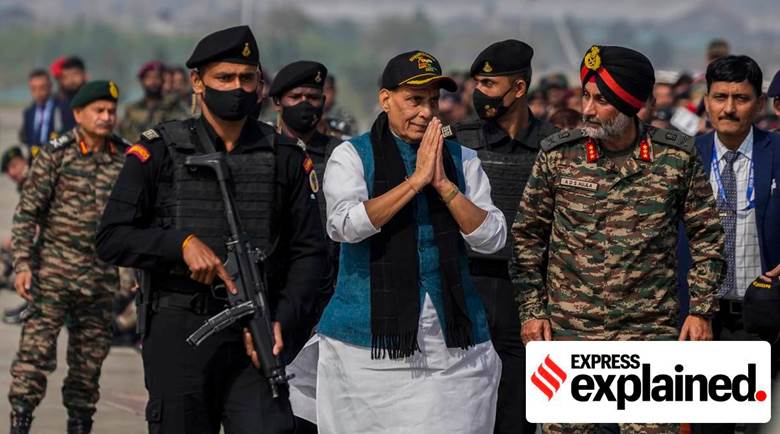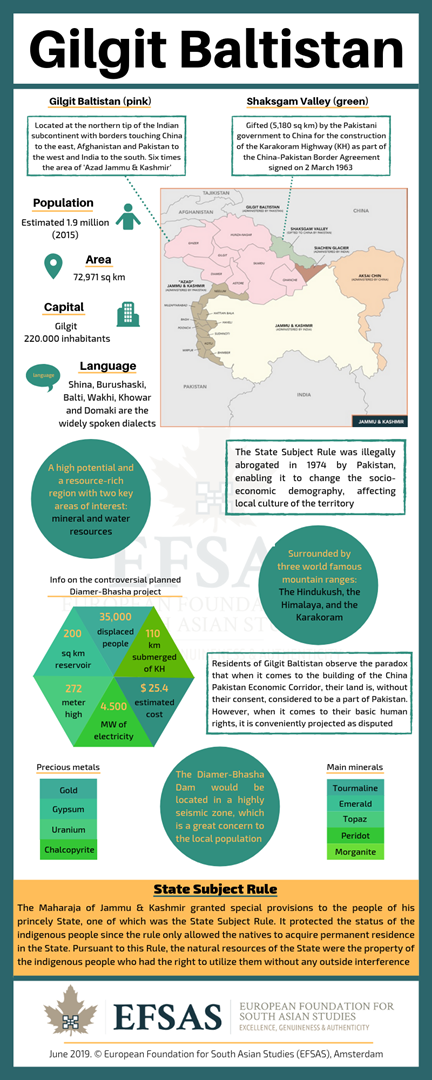
Disclaimer: Copyright infringement not intended.
Context: Defence Minister Rajnath Singh on Thursday (October 27) said India had “only just begun walking north”, and the journey would end when “we…reach the remaining parts (of PoK), Gilgit and Baltistan”. This, he said, would “implement the resolution passed unanimously by India’s Parliament on February 22, 1994”.
Details:
What’s the historical background of this region?
- The British sold it, along with the rest of Jammu and Kashmir, to the Dogra ruler of Jammu, Gulab Singh, after defeating the Sikh army in 1846, but retained controlled over the area through a lease extracted from the Maharaja.
- On November 1 1947, after J&K ruler Hari Singh had signed the Instrument of Accession with India,and the Indian Army had landed in the Valley to drive out tribal invaders from Pakistan, there was a rebellion against Hari Singh in Gilgit.
- Pakistan did not accept G-B’s accessionalthough it took administrative control of the territory.
- After India went to the UN and a series of resolutions were passed in the Security Council on the situation in Kashmir, Pakistan believed that neither G-B nor PoK should be annexed to Pakistan, as this could undermine the international case for a plebiscite in Kashmir.
Why special status for this region?
- Though both PoK and GB are ruled directly from Islamabad, both are “autonomous territories”.
- During the first Indo-Pak war of October 1947, Pakistan occupied 78,114 sq km of the land of Jammu and Kashmir, including the ‘Northern Areas’.
- The Northern Areas is the other name of Gilgit-Baltistan that Pakistan has used for administrative reasons because it was a disputed territory.
- Pakistan initially governed the region directly from the central authority after it was separated from ‘Azad Jammu and Kashmir’ on April 28, 1949.
- Under Prime Minister Zulfiqar Ali Bhutto, the name of the region was changed to the Federally Administered Northern Areas (FANA).
- Pakistan passed the Gilgit-Baltistan Empowerment and Self Governance Order in 2009, which granted “self-rule” to the ‘Northern Areas’.
- The local situation altered considerably with Pakistan signing an agreement with China for mega infrastructure and hydel power projects in September 2009.
Why “Statehood”?
- On January 17, 2019, a seven-judge bench of the Supreme Court of Pakistan, took up the constitutional status of Gilgit-Baltistan.
- The purpose of the court’s intervention was to determine the extent of political rights that could be enjoyed by the people of the ‘Northern Areas’.
- Over the years, the region has de facto status of a province of Pakistan, but the constitutional status of the region remained vague without explicit statehood.
- The Supreme Court allowed Islamabad to amend a 2018 administrative order to hold general elections in the region.
- The Gilgit-Baltistan Order of 2018 provided for administrative changes, including empowering the Prime Minister of Pakistan to legislate on an array of subjects.
Why this region matters for both countries?
- It is one of the most mountainous regions in the world that is rich with mines of gold, emerald and strategically important minerals. It’s home to K-2,the second tallest mountain in the world.
- It is known for its extraordinary scenic beauty, diversity and ancient communitiesand languages. It has some of the ancient Buddhist sculptures and rock edicts.
- It is also home to an old Shia community, which often finds itself subjected to persecution in Pakistan’s urban centres.
- This water-rich regionis known for high altitude dams, its biggest hydroelectricity project is the Diamer-Bhasha dam, which was launched in July 2020.

What’s India's stand?
- India reiterated its territorial sovereigntyover the region.
- Ministry of External Affairs stated that the Pakistani move to change the status of the region will “have no legal basis whatsoever”.
- India has consistently opposed Pakistan’s activities in Gilgit-Baltistan.
- It also opposed the announcement of the commencement of the Diamer-Bhasha dam in July.
- There have been local and international concerns as reports suggest priceless Buddhist heritage will be lost once the dam is built.
- India has objected to the use of Gilgit-Baltistan to build and operate the China Pakistan Economic Corridor (CPEC), which cuts through the region before heading to the Arabian Sea coastline of Balochistan’s Gwadar port.
- India launched a new political map last November, which showed the Gilgit-Baltistan region as part of the new Union Territory of Ladakh.
What lies across the LoC?
- Pakistan Occupied Kashmir is an area of 13,297 sq km, which was under the control of the Pakistani forces when the ceasefire line came into effect on January 1, 1949.
- In 1963, through an agreement, Pakistan ceded to China over 5,000 sq km of J&K land under its control, in the Shaksgam area, in northern Kashmir, beyond the Karakoram.
Why this region is strategically important?
- Gilgit-Baltistan is the only territorial frontier, and thus a land route, that connects Pak. with China, where it meets the Xinjiang Autonomous Region.
- To G-B’s west is Afghanistan, to its south is Pakistan-occupied Kashmir, and to the east J&K.
- For India, the region represents the continuity with the past of Jammu and Kashmir, which included Gilgit-Baltistan at the time of Partition of 1947.
- The ongoing stand-off with China at the Line of Actual Control in Eastern Ladakh has a Gilgit-Baltistan connection as the Darbuk-Shyok-DBO road of India is viewed as a tactical roadway to access the Karakoram Pass, which provides China crucial access to Gilgit-Baltistan and Pakistan.

What do the people in G-B want?
- The people of G-B have been demanding for years that it be made a part of Pakistan,they do not have the same constitutional rights Pakistanis have.
- There is virtually no connect with India, the people of G-B have no real connect with Kashmir either.
- They belong to several non-Kashmiri ethnicities, and speak various languages, none of these Kashmiri.
- A majority of the estimated 1.5 million G-B residents are Shias, with the predominant sentiment that their conditions will improve once they are part of the Pakistani federation.
- There is a small movement for independence, but it has very little traction.
https://indianexpress.com/article/explained/rajnath-singh-gilgit-baltistan-history-explained-8234674/





